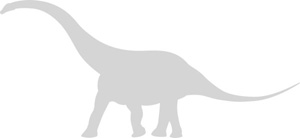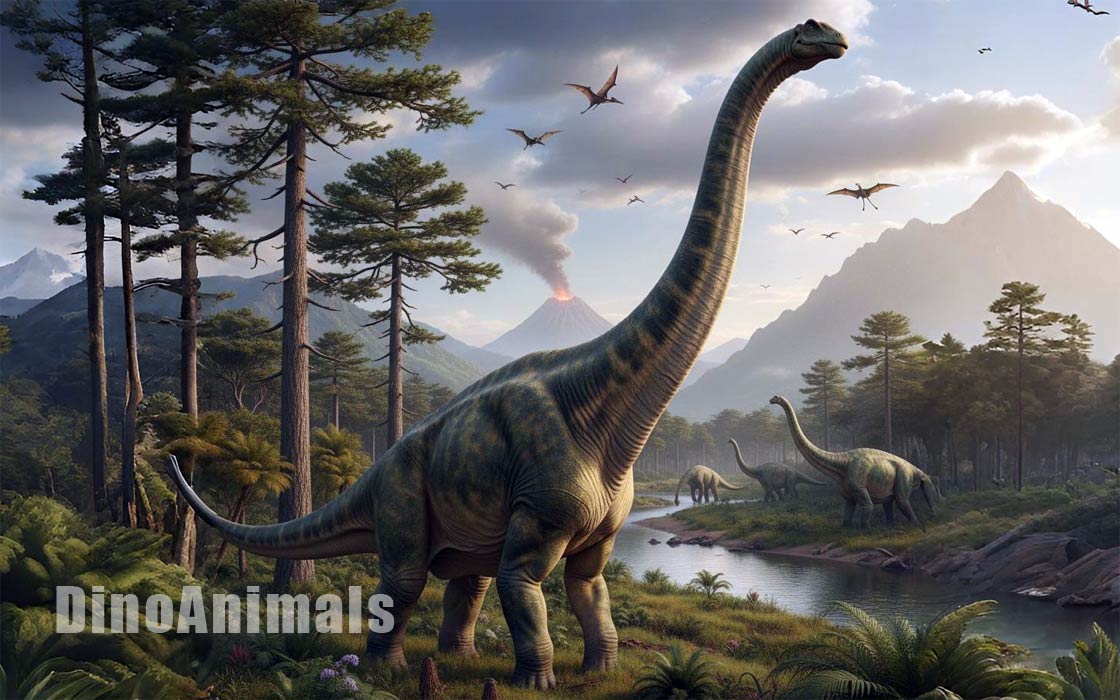Every month, 100,000 readers use the Dinosaur Database, but we receive no support from you. Developing and updating the database requires a lot of work. If you want it to remain open and be updated, please support us via the "Buy us a coffee" button available on every page or via the Support page.
Dinosaur: Argentinosaurus huinculensis

| Length*: | 34 m | 111.5 ft |
| Weight*: | 78 t | 171,960 lb |
| Speed: | 7 km/h | 4 mph |
*The largest known specimen
Period
Epoch: Late Cretaceous
Stage: Cenomanian
Years: 96.2–92.19 Ma
Details
Status: valid
Author: Bonaparte & Coria
Year: 1993
Distribution
Area: South America
Country: Argentina
Region: Neuquén
Formation: Huincul
Description
Argentinosaurus huinculensis
Argentinosaurus huinculensis was one of the largest known dinosaurs and the most massive terrestrial animal to have ever lived. This colossal sauropod inhabited what is now South America during the Late Cretaceous period, approximately 96–92 million years ago. The name “Argentinosaurus” translates to “Argentine lizard,” reflecting the country where its remains were discovered, while “huinculensis” refers to the Huincul Formation in Patagonia, where the first fossils were unearthed. As a member of the titanosaur family, Argentinosaurus showcases the incredible diversity and evolutionary success of sauropods, which dominated terrestrial ecosystems during the Mesozoic Era.
Physical Characteristics
Argentinosaurus huinculensis was an enormous dinosaur, with estimates suggesting it reached lengths of 30–35 meters (98–115 feet) and weighed between 60 and 80 metric tons. This herbivore had a long neck, which allowed it to reach high into trees to feed on leaves and branches, and an equally long tail, which may have been used for defense or communication. The vertebrae of Argentinosaurus were massive, with some individual bones exceeding 1.5 meters (5 feet) in height. Its bones were also highly pneumatic, filled with air sacs that reduced weight without compromising strength. This adaptation was crucial for supporting its enormous size. The limbs of Argentinosaurus were thick and pillar-like, designed to bear immense weight and provide stability. Despite its great size, its limb bones suggest it could move slowly but steadily, with a wide, stable stance.
Diet and Feeding Habits
As a giant herbivore, Argentinosaurus huinculensis fed on a variety of plant materials, including conifers, ferns, cycads, and other vegetation that thrived in its environment. With its long neck, Argentinosaurus could reach foliage that was inaccessible to smaller herbivores, allowing it to exploit a range of food sources. It likely stripped leaves and branches using its peg-like teeth, which were not adapted for chewing but rather for stripping foliage. After ingesting its food, Argentinosaurus would rely on its large, fermentation-based digestive system to break down the tough plant material over time. This method of feeding and digestion is typical of sauropods, which required large quantities of food to sustain their massive size.
Habitat and Distribution
Argentinosaurus huinculensis lived in what is now Patagonia, Argentina, specifically in the Huincul Formation, an area known for its rich fossil deposits from the Late Cretaceous. During this period, the region was characterized by a warm, semi-arid climate with seasonal rainfall. The landscape consisted of floodplains, river systems, and areas with sparse vegetation, such as coniferous forests and fern prairies. The environment provided ample food resources for a large herbivore like Argentinosaurus. This habitat would have supported a diverse ecosystem with other large herbivores, as well as predators like Mapusaurus and Giganotosaurus, which may have posed a threat, especially to younger or sick individuals.
Behavior and Social Structure
While the behavior of Argentinosaurus huinculensis remains speculative, it is likely that, like other sauropods, it lived in herds. Herding would have provided protection against predators and facilitated access to food and water resources. Fossil evidence from related sauropods suggests that they may have migrated in search of fresh vegetation and water, moving across large areas to meet their enormous dietary needs. Argentinosaurus may have communicated with other members of its species through low-frequency vocalizations or physical signals, such as tail movements. These behaviors would have been essential for maintaining group cohesion and avoiding predators. The size of an adult Argentinosaurus would have made it largely invulnerable to predation, but younger individuals might have relied on the protection of the herd.
Discovery and Research
Argentinosaurus huinculensis was first discovered in 1987 by Guillermo Heredia, a rancher, on his farm “Las Overas” about 8 km (5 mi) east of Plaza Huincul, in Neuquén Province, Argentina. The fossils, including massive vertebrae and rib fragments, were excavated by paleontologist José F. Bonaparte and his team and formally described in 1993. Since then, additional fragments attributed to Argentinosaurus have been found, though no complete skeleton has been unearthed to date. Much of what is known about Argentinosaurus comes from comparisons with related titanosaurs, such as Dreadnoughtus and Patagotitan. Research is ongoing, with scientists using advanced imaging techniques and biomechanical modeling to estimate its size, weight, and locomotion. New finds continue to shed light on the anatomy and lifestyle of this extraordinary dinosaur.
Significance and Interesting Facts
Argentinosaurus huinculensis is significant not only for its enormous size but also for what it reveals about the evolution and ecology of titanosaurs. As one of the largest land animals ever, it illustrates the incredible diversity and adaptability of sauropods, which thrived for millions of years. The discovery of Argentinosaurus has also helped paleontologists understand the Late Cretaceous ecosystems of South America, highlighting the presence of giant herbivores and the unique adaptations that allowed them to thrive in a challenging environment. Its size and the conditions required to sustain such a large animal provide insights into the climatic conditions, plant life, and interspecies relationships of its time. The ongoing study of Argentinosaurus contributes to our understanding of how such massive creatures could function and survive in prehistoric ecosystems.
Locations
Sources
Material: Six dorsal vertebrae, sacrum, fragmentary ribs and fibula. Referred two femora.
References: Bonaparte J, Coria R (1993). "Un nuevo y gigantesco sauropodo titanosaurio de la Formacion Rio Limay (Albiano-Cenomaniano) de la Provincia del Neuquen, Argentina".




